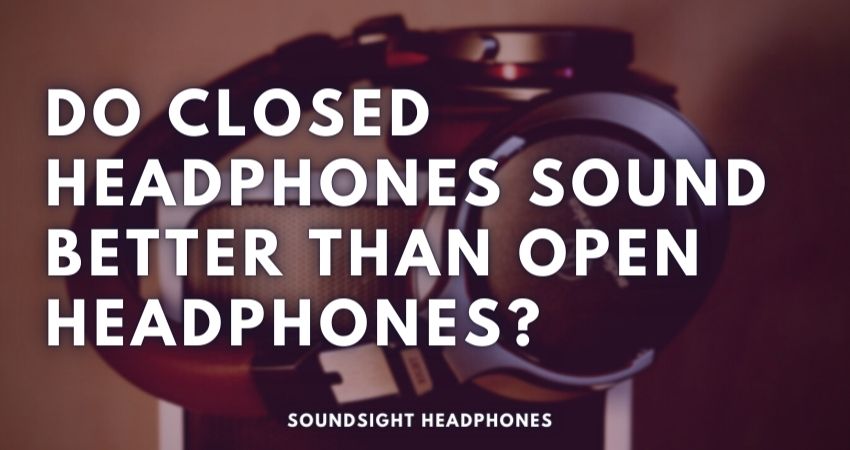Do closed-back headphones sound better than open-back headphones? The answer is not simple, and often depends on your needs, preferences and listening conditions. Closed or sealed designs can be used by audio engineers in recording settings because they block background noise. Open designs certainly do not provide the same isolation benefits. Still, they produce a more natural sound with refreshingly natural reproduction and a sense of air and space between instruments in the recordings that helps mix and master.
Closed and Open Headphones – Which Sounds the Best?
To understand whether closed headphones sound better or worse than open ones, we have to first discuss what is meant by “sound quality.” In this context, the word “quality” is not defined as the perceived level of fidelity an audio device brings to the music. Instead, it refers to the degree that headphones can bring our ears into a musical event.
The Sound of Closed Headphones and How It Compares to Open Headphones
There are multiple reasons why closed headphones sound better than open headphones. In general, the noise-isolating effect of the closed headphone cancels out ambient noise, making for a more enjoyable listening experience. However, open-back headphones tend to perform better than closed headphones in ideal listening conditions.
Situations When Closed Headphones Sound Amazing
Closed-back headphones do a better job of bringing your ears to a more intimate experience because they completely block out outside noise and bring the music closer to you. The soundstage seems narrower but places the instruments on multiple layers. While the music’s pace, timing, and rhythm are not as natural and accurate as with open headphones, closed headphones deliver a deep, authentic sound with plenty of clarity and impact.
That’s why audiophiles tend to like open-air headphones, and consumers tend to look for closed-air headphones. Open-back audiophile headphones are more organic, more transparent, the notes are more articulate and the overall quality of sound is better than in closed headphones.
The public prefers closed-back headphones because they sound more engaging and exciting than open headphones. They give them the fullness, detail, and excitement they’re looking for in their favorite music. It’s the perfect balance between fun and excessive details.
Closed-back headphones can be used when you are in a situation where you need to block out outside noise. This could be on a plane, office, in a car, or even in a recording studio where you must keep the sound contained, so it doesn’t reach the microphone and ruin your recording session. As such, the acoustics of closed headphones are better suited to situations where open headphones are not.
Pros:
- Fullness and physical sound
- Ample soundstage
- Warm, rich sound
- Great for Listening to Music, Gaming, Watching Movies, Recordings, Traveling, etc.
Cons:
- Have a less natural and accurate sound than open headphones.
- The bass tends to be muddy or loose.
What is Special About the Sound of Open Headphones?
Open-back headphones also allow a wider range of frequencies to be heard. For example, open-back headphones can reveal sibilance and plosive consonants, whereas closed-back headphones are incapable of doing so.
Open-back headphones do not have a closed enclosure, allowing the music to be reproduced more naturally. At the same time, open-back headphones deliver a clearer and more balanced sound signature. The user can enjoy a more accurate sound and a wider soundstage. Some people even feel that open-back headphones provide a more “live” ambiance.
The low-end bass frequencies are simply missing from closed headphones compared to open-back headphones, whereas open headphones don’t have the same impressive thump as closed headphones. In summary, there are plenty of reasons why one type of headphone outperforms another in certain situations.
Pros:
- More natural and lifelike sound
- Higher fidelity and clarity
- Wider soundstage and better positioning of instruments
- More accurate with plosive consonant consonants
- Fantastic for Music listening, gaming, mixing, and mastering
Cons:
- Less momentum, physicality, and excitement
- Trebles may sound harsh or sharp
- Not good for commuting, traveling, or recording
Not All Closed-Back and Open-Back Headphones Sound The Same
It’s not ideal to say that some closed-back headphones sound better than open-back headphones or vice versa when even closed-back headphones themselves don’t sound all equally good. Some play music with more detail, enthusiasm, completeness, and clarity.
Factors such as driver type, driver size, acoustic implementations involving different materials, and how the drivers are mounted can have a more dramatic effect on the resulting sound than a closed or open-back design.
Open-back Planar Headphones Offer Loud and Tight Basses
Open planar headphones, for example, are considered to have a stronger bass response than dynamic, open headphones while having a tight bass, if not tighter. They give you the best of both worlds, tight bass with a lot of volume.
The large 4 inches (ca. 10 cm) planar drivers, and the great precision with which they play, are what make planar headphones so successful for bass reproduction in particular. The bass response of planar headphones isn’t as succulent as that of dynamic headphones, but they sound much better than regular open-back headphones.
A great example of bassy open-back planar headphones is HiFiMan HE-400 and HiFiMan Sundara. Both of these models have a best-in-class bass performance and provide deep bass. HiFiMan’s HE400i is a great introduction to planar magnetic headphones. It separates itself from the competition through its great musicality, comfort, and build quality. The Sundara is a newer version that looks and feels more like a luxury product.
Closed-back and Open-back IEMs (In-Ear Monitors)
When talking about closed and open headphones, earbuds and professional in-ear monitors also employ the same design concepts. In-ear monitors are also made as both open-back and closed-back earphones, with different sound signatures between the two.
Unlike full-size headphones, in-ear monitors have different sonic characteristics while having a closed housing with small air vents.
When comparing open-back headphones to regular closed in-ear headphones, you’ll be surprised by the presence of more bass, even though the difference in drivers size is incomparable.
For instance, hard dome dynamic drivers are known for their faster response speed and lower distortion, improving low-end extension. Yet these drivers are known for major bass bloat and lack of detail in the higher frequencies. While some open-back in-ear headphones like Audeze iSine 10 have an open-back design and planar magnetic drivers, resulting in deep and articulate bass response and improved low-frequency separation.
The overall tonality of in-ears is not comparable to regular full-size headphones. It’s a different type of sound, not better or worse. You just need to know what to expect when you try either type of headphones. However, when it comes to which one plays music better, it’s known that closed-back in-ear headphones sound better than open-back ones and bone-conduction headphones.

Particularities About Music Listening
If we could hear everything as accurately in real life as with high-end audio equipment, there would be no difference between closed and open headphones. Isolation is a compromise: it protects your ears from acoustic overload but reduces low-frequency fidelity.
Music is Meant to be Experienced Live – Closed Headphones Can’t Provide That
In real life, though, listening is not quite the same as experiencing music live and with your entire body. Why is this the case? When you listen to music on headphones, some sounds will be physically impossible for your ears and body to perceive.
The brain can only process a limited amount of information in real-time. If a musical event takes place (for example) behind you and to the left of your head, there’s no way for the sound waves to reach your ears and ears alone, as they would have to travel through multiple other bodies before reaching you. Thus, experiencing true live music via headphones is impossible.
Takeaway: Music is meant to be experienced live, but through headphones, it sounds differentAcoustic Limitation of Open and Closed Headphones
Because of these limitations, when you listen to music on headphones, you cannot completely recreate the experience of being live in the same space as the musicians. The brain interprets low-frequency sounds differently than it interprets high-frequency sounds, based on how long it takes these waves to reach our ears.
Open-Back Headphones and Their Live Sound
Nevertheless, some headphones do a fantastic job of bringing the concert live-type-of-music closer to your ears to help you experience things as they would be if you were experiencing them in a real-world situation. In this case, open-back headphones have a good handle on large-scale dynamics, high-end detail, and definition.
The expansive soundstage and open feel of the sound flowing around you make instruments sound real, and the bass response brings out the deepest notes without being too heavy. The presence of sub-bass and low frequencies provides a fuller listening experience with more layers of sound, so you can get a strong sense of low-frequencies with good depth that you’d notice with closed-back headphones.
The Engaging Sound of Closed-Back Headphones
Indeed, closed-back headphones cannot bring everything to you as it would be if you were listening live. What goes in favor of closed-back headphones is their specifically tailored sound with a very defined, realistic, and engaging low-frequency response.
With closed-back headphones, it’s easy to create a sense of depth between front and back instruments and vocals. Still, because the effect reproduced is generated through the acoustic means of a closed pair of headphones, there’s a sense of isolation and reverberation.
The compact soundstage of closed headphones is more or less average as far as how it translates sound; however, the deep and strong bass makes instruments sound very natural and highly detailed.
In the end, closed-back headphones commonly bring a more “dynamic” feel to the music, but it is important to note that it is not always better or more revealing than the sound provided by open-back headphones.
Conclusion
As you can see, open and closed headphones have many differences and little things that make each of them interesting.
Closed headphones tend to bring a more exciting sound to the music, but in the end, open-back headphones deliver a crisper, clearer, and more accurate sound. Perhaps it is better to ask yourself what kind of music you listen to most to understand which type will give you the best experience for your needs.
